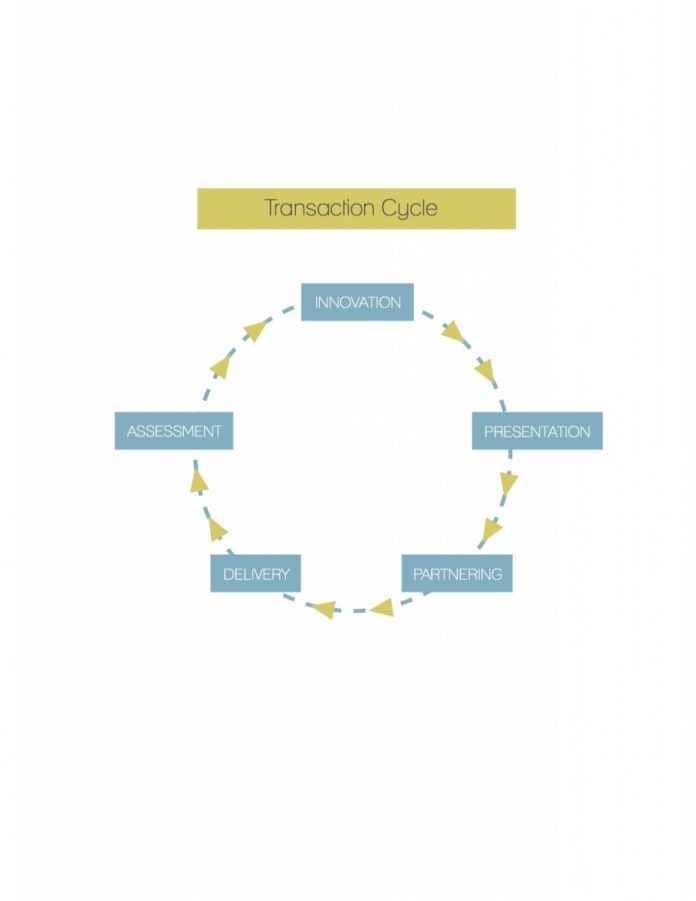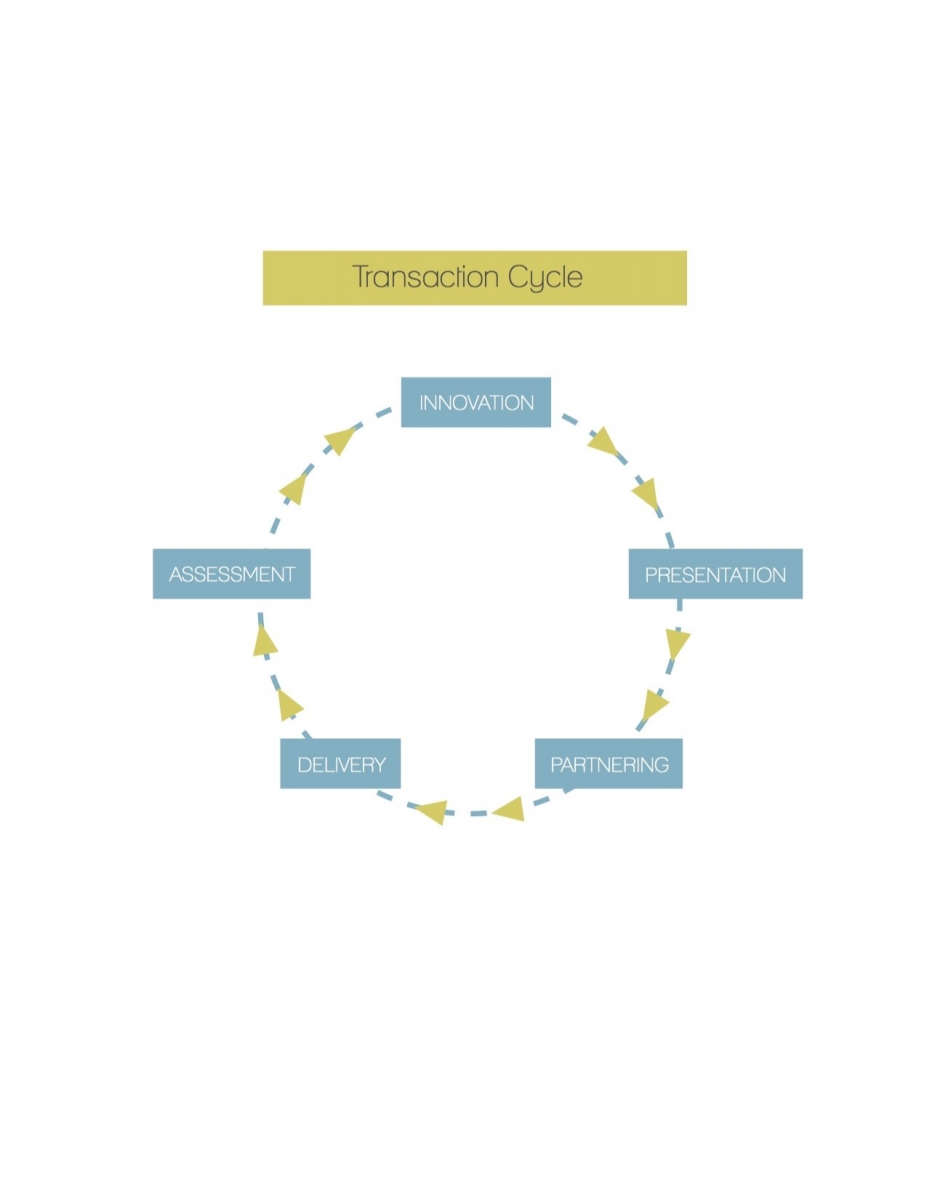
Senior-level training positions are more gratifying when you’re considered a valued C- suite partner. Having a seat at the table means training is regarded as strategic, not tactical. This article discusses two important dynamics necessary to achieve this coveted status. The first is being able to appreciate the “big picture.” The second is understanding how and where you add strategic value.
Training, first and foremost, is a business transaction. Business transactions are graphically depicted below in our five-phase transaction cycle; understand this model and you’ll easily grasp the big picture. As we describe each phase of the transaction, it will become clear that each phase requires unique personality strengths to complete. Once you identify where on the transaction cycle your individual strengths are optimized, you can begin to think more strategically about the entire transaction.
Let’s look at an example that illustrates our point. Assume the SVP of sales asks you to develop and then deliver a consultative selling skills training program; the executive team is under pressure to grow revenue.
Phase One: Innovation. Phase One is the design of the training experience using applied imagination, creativity, and originality. Due diligence is necessary to understand how the company is positioned in the marketplace, what skills need improvement, what top performers are doing differently, how salespeople add strategic value to client relationships, etc. The most important skill in this phase is generating ideas, exploring options, and posing questions that cause senior management to re-think, or consider a new perspective.
Brainstorming and asking deep questions will begin to create the framework for the training. You want your internal customers (the SVP and sales leaders) to feel energized and challenged when you ask questions that cause them to think differently—thus, changing their perception of you.
Phase Two: Presentation. Phase Two is influencing and persuading; initiating contact and interpersonal interaction. This is when you deliver dynamic pitches to promote the upcoming experience. The most important skill in this phase is extroversion—selling ideas with passion, energy, and enthusiasm.
This phase considers options on how to frame your message to get sales managers and salespeople excited and motivated about the training event. The objective is to generate enthusiasm and for participants to believe this will be a unique opportunity to develop professionally.
Phase Three: Partnering. Phase Three is open communication, collaborating, listening, empathizing, and seeking a win-win dynamic. The most important skill in this phase is being able to partner—seeking management input and support in developing the specifics of the curriculum.
Key managers can make or break a training initiative. By soliciting the contribution and participation of line managers, they’ll feel more engaged and willing to take ownership. They’ll undoubtedly bring you ideas and insights that will help you to create a more robust event. The perception of you will transform when line managers see, perhaps for the first time, that they have a real training partner to help their people become more successful.
Phase Four: Delivery. Phase Four is following through to manage the entire project effectively. The most important skill is conscientiousness; the ability to execute and deliver on what has been promised. This is where the rubber meets the road, where every detail—from coffee to technology—must be managed.
Here, each aspect of the program is examined and structured so the entire event is flawlessly delivered. Detail analysis, developing processes, logistics, flow charts, and timetabling are coordinated. The obvious goal here is that once the event is over, management and participants will appreciate the organizational complexity and admire how well the event was executed.
Phase Five: Assessment. Phase Five is objective, rational evaluation, and systematic analysis. The important skill in this phase is the ability to dispassionately assess the entire effort’s effectiveness.
Post training metrics are accumulated and analyzed and feedback forms are reviewed. Interviews are scheduled to learn what worked, what could have been improved, what behaviors ultimately were affected, and what top-line growth occurred. This is when a trainer looks rationally at data and facts and connects the dots to assess the results. This is another opportunity for you to expand your influence by presenting what was accomplished and how the program can be enriched. Here, you integrate agreed upon improvements to reinvent for subsequent training events.
All five phases of the transaction cycle must be completed, yet very specific strengths and competencies are required to complete each phase. The following diagram represents the holistic flow:
1. Innovation 2. Presentation 3. Partnering 4. Delivery 5. Assessment

Where do you individually perform your best? Which phase feels most intuitive and natural? Which phase(s) feel like real work? Try rank ordering your five phases, one being where you are strongest, then two, three, four, and five.
When work is fun, you’re tapping into natural personality strengths. This is where you should focus individual efforts; only when you use natural strengths will you add strategic value. Our coaching recommendation is to structure your activities around the phase that best leverages your strength(s). Build partnerships or delegate the other phases of the transaction cycle, especially tasks associated with the phases you ranked four and five.
Many Training professionals lack a big picture, business perspective. They think tactically as opposed to strategically. When you understand the big picture and optimize your personality strength(s), you will better drive the success of the entire transaction. By shifting your thinking, you will quickly be viewed differently. Master these two dynamics and you’ll be taking a seat at the table!
Dr. George Watts is chairman and Laurie Blazek is president and CEO of Top Line Talent, a leadership and sales training and consulting firm that helps leaders and salespeople think more strategically and add more value to deals and teams. To learn about Top Line’s program(s) or its customized online consultative selling skills course, Top Line Talent, visit: www.toplinetalent.com or e-mail info@toplinetalent.com.



